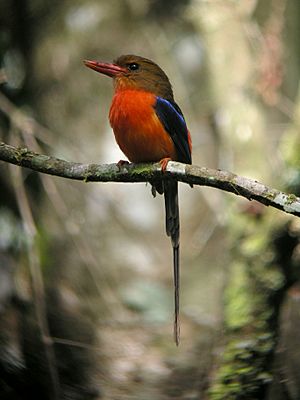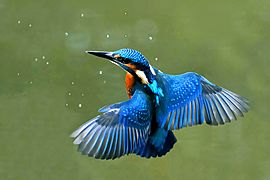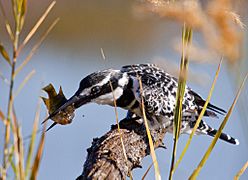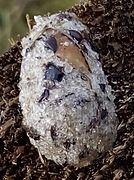Kingfisher facts for kids
Quick facts for kids Kingfisher |
|
|---|---|
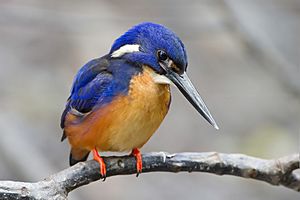 |
|
| Azure kingfisher (Ceyx azureus) | |
| Scientific classification |
|
| Kingdom: | Animalia |
| Phylum: | Chordata |
| Class: | Aves |
| Order: | Coraciiformes |
| Suborder: | Alcedines |
| Family: | Alcedinidae Rafinesque, 1815 |
| Subfamilies | |
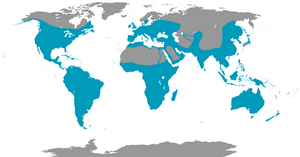 |
|
| Global distribution of the kingfishers | |
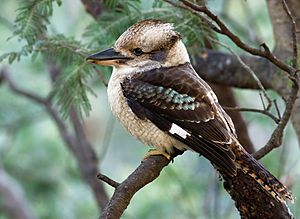
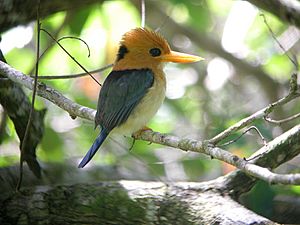
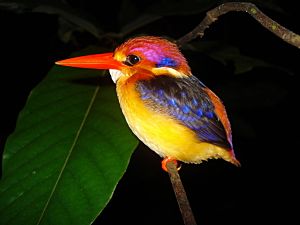

Kingfishers are a group of small to medium-sized birds. They are known for their bright colors. There are 116 different kinds, or species, of kingfishers. Most of them live in warm, tropical places like Africa, Asia, and Oceania. Some can also be found in Europe.
Kingfishers often live in deep forests near calm ponds and small rivers. All kingfishers have big heads and long, sharp beaks. They also have short legs and short tails. Many people think kingfishers only eat fish. But many species live far from water and eat small insects instead. Like other birds in their group, kingfishers make their nests in holes. These holes are usually tunnels dug into riverbanks. Some even nest inside termite mounds!
Contents
All About Kingfishers
Kingfishers belong to a bird family called Alcedinidae. This family is part of a larger group of birds called Coraciiformes. This group also includes birds like motmots and bee-eaters. The name "kingfisher" was first used in 1815.
There are three main groups, or subfamilies, of kingfishers:
- Tree kingfishers (Halcyoninae)
- River kingfishers (Alcedininae)
- Water kingfishers (Cerylinae)
Even though they are all called "kingfishers," not all of them eat fish. For example, none of the tree kingfishers eat fish.
Scientists believe kingfishers first appeared in Asia about 27 million years ago. From there, they spread to other parts of the world. Fossils of ancient kingfishers have been found in rocks. Some of these fossils are 30 to 40 million years old!
What Do Kingfishers Look Like?
Kingfishers come in many sizes. The smallest is the African dwarf kingfisher. It is only about 10 centimeters (4 inches) long. It weighs about 9 to 12 grams (0.3 to 0.4 ounces). The largest kingfisher in Africa is the giant kingfisher. It can be up to 46 centimeters (18 inches) long. It can weigh up to 426 grams (15 ounces). The heaviest kingfisher is the laughing kookaburra from Australia. Females can weigh almost 500 grams (1.1 pounds).
Most kingfishers have very bright feathers. Green and blue are the most common colors. Their bright colors come from the way their feathers are built. This structure scatters blue light, making them look so vibrant. Male and female kingfishers usually look very similar. If there are differences, they are very small.
Kingfishers have long, sharp beaks that look like daggers. Birds that hunt fish usually have longer, thinner beaks. Those that hunt on the ground have shorter, wider beaks. The shovel-billed kookaburra has a very unique, wide beak. It uses it to dig for food in the forest floor. Kingfishers generally have short legs. However, species that hunt on the ground have longer legs. Most kingfishers have four toes. Three of these toes point forward.
Kingfishers have excellent eyesight. Their eyes are dark brown. They can see very well in color. They can also see with both eyes at once. This helps them judge distances. They move their heads a lot to track prey. They can even adjust their vision when hunting underwater. This helps them see fish clearly. They also have special membranes that cover their eyes. These protect their eyes when they dive into the water.
Where Do Kingfishers Live?
Kingfishers live all over the world. They are found in tropical and mild climate regions. They do not live in very cold places or in the driest deserts. Many species have flown to islands, especially in the Pacific Ocean. Most kingfishers live in the Old World tropics and Australia.
Europe and North America have very few kingfisher species. For example, the United States has only two common types. These are the belted kingfisher and the green kingfisher. In comparison, the small country of Gambia in Africa has eight different kinds of kingfishers.
Some kingfishers live in huge areas. The common kingfisher lives from Ireland all the way to the Solomon Islands. The pied kingfisher is found across Africa and Asia. Other species live in very small areas. Some only live on a single small island. The Kofiau paradise kingfisher only lives on Kofiau Island near New Guinea.
Kingfishers live in many different places. While many are linked to rivers and lakes, more than half of all species live in forests. They also live in open woodlands and on tropical coral islands. Some kingfishers have learned to live near people. They can be found in farms, parks, and even city gardens.
Kingfisher Behavior and Life Cycle
What Kingfishers Eat
Kingfishers eat many different kinds of food. They are famous for catching and eating fish. But many species also eat crabs, frogs, worms, snails, and insects. Some even eat spiders, centipedes, snakes, and small birds or mammals. What a kingfisher eats can depend on where it lives.
Forest kingfishers mostly eat insects, like grasshoppers. Water kingfishers are better at catching fish. The red-backed kingfisher has been seen breaking into the mud nests of other birds. It does this to eat their babies. Kingfishers usually hunt from a high spot. When they see food, they swoop down to grab it. Then they fly back to their perch. Larger prey is often hit against the perch. This kills the prey and breaks any sharp parts. After that, the kingfisher swallows its meal. Sometimes, they cough up a pellet. This pellet contains bones, scales, and other parts they cannot digest.
-
Common kingfisher hovering
-
Giant kingfisher breaking spine of tilapia fish
-
Pied kingfisher killing a fish
Kingfisher Reproduction
Kingfishers protect their home areas. They are usually monogamous, meaning they have one mate. But some species, like the laughing kookaburra, have helpers. These helpers are other birds that assist the main pair in raising their young.
Kingfishers build their nests in holes. Most species dig tunnels in earth banks. These banks are often found along rivers or lakes. Some kingfishers nest in holes in trees. Others use the earth around the roots of fallen trees. Some forest species nest in termite mounds. The nest is a small room at the end of a tunnel. Both male and female kingfishers help dig the nest. They sometimes fly at the chosen spot with great force to start digging.
The length of the tunnels changes. Nests in termite mounds are shorter than those dug into the ground. Nests in hard soil are shorter than those in soft sand. The longest kingfisher tunnels ever found were 8.5 meters (28 feet) long. These belonged to the giant kingfisher.
Kingfisher eggs are always white. The number of eggs laid depends on the species. Some lay as few as two eggs. Others can lay up to 10 eggs. Most lay about three to six eggs. Both parents take turns sitting on the eggs to keep them warm. Young kingfishers usually stay with their parents for 3 to 4 months.
Kingfishers and Conservation
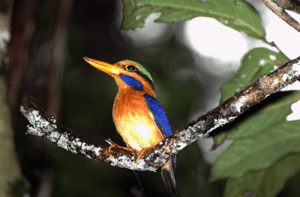
Some kingfisher species are in danger of disappearing. This is often due to human activities. Many of these are forest species that live in small areas. They are threatened by the loss of their homes. Forests are being cleared or damaged. Sometimes, new animals brought by humans also cause problems. For example, the Marquesan kingfisher is in great danger. Its habitat is being destroyed by introduced animals.
Kingfishers in Human Culture
Kingfishers are usually shy birds. But they are often seen in human stories and art. This is because of their big heads, bright colors, or interesting behaviors.
For the Dusun people in Borneo, seeing an Oriental dwarf kingfisher is a bad sign. Warriors who see one on their way to battle might go home. Another tribe in Borneo sees the banded kingfisher as a good sign.
The sacred kingfisher was special to the Polynesians. They believed it could control the seas and waves.
Ancient Greek myths also tell stories about kingfishers. One myth tells of a couple named Alcyone and Ceyx. They were turned into kingfishers by the gods. The gods also gave them "halcyon days." These are seven days around the winter solstice when the weather is always calm. This was so the kingfishers could safely raise their young. Today, "halcyon days" means a peaceful or ideal time in the past.
Many things are named after this myth:
- The bird group Ceyx is named after Ceyx.
- The kingfisher group Halcyoninae is named after Alcyone. So is the bird group Halcyon.
- The belted kingfisher's scientific name also refers to Alcyone.
The word "kingfisher" itself has a less clear origin. It comes from "king's fisher." But why this name was chosen is not fully known.
See also
 In Spanish: Alcedínidos para niños
In Spanish: Alcedínidos para niños


